
The AK-74 is an assault rifle designed by small arms designer Mikhail Kalashnikov in 1974 as a successor to the AKM. While primarily associated with the Soviet Union, it has been used by many countries since the 1970s. It is chambered for the 5.45×39mm cartridge, which replaced the 7.62×39mm cartridge of Kalashnikov's earlier automatic weapons for the Soviet Armed Forces.

The Karabiner 98 kurz, often abbreviated Karabiner 98k, Kar98,Kar98k or K98k and also sometimes incorrectly referred to as a K98, is a bolt-action rifle chambered for the 7.92×57mm Mauser cartridge. It was adopted on 21 June 1935 as the standard service rifle by the German Wehrmacht. It was one of the final developments in the long line of Mauser military rifles.
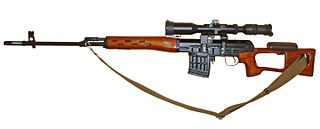
The SVD, GRAU index 6V1, is a semi-automatic designated marksman rifle/sniper rifle chambered in the 7.62×54mmR cartridge, developed in the Soviet Union.
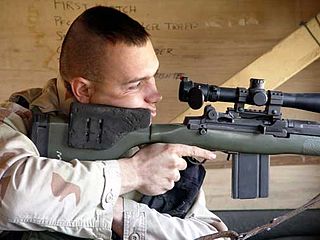
A designated marksman (DM), squad advanced marksman (AD) or squad designated marksman (SDM) is a military marksman role in an infantry squad. The term sniper was used in Soviet doctrine although the soldiers using the Dragunov SVD were the first to use a specifically designed designated marksman rifle.

The 7.62×54mmR is a rimmed rifle cartridge developed by the Russian Empire and introduced as a service cartridge in 1891. Originally designed for the bolt-action Mosin–Nagant rifle, it was used during the late tsarist era and throughout the Soviet period to the present day. The cartridge remains one of the few standard-issue rimmed cartridges still in military use, and has one of the longest service lives of any military-issued cartridge.

A designated marksman rifle (DMR) is a modern scoped high-precision rifle used by infantry in the designated marksman (DM) role. It generally fills the engagement range gap between a service rifle and a dedicated sniper rifle, at around 300–600 metres (330–660 yd).

The Gewehr 98 is a bolt-action rifle made by Mauser for the German Empire as its service rifle from 1898 to 1935.
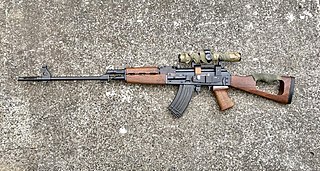
The Tabuk Sniper Rifle is an Iraqi semi-automatic designated marksman rifle, made from a modified version of the Zastava M76 sniper rifle. The Tabuk Rifle was manufactured at the Al-Qadissiya Establishments in Iraq using machinery sold to Iraq by Zastava Arms of Yugoslavia when Saddam Hussein was president.

The 7.92×57mm Mauser is a rimless bottlenecked rifle cartridge. The 7.92×57mm Mauser cartridge was adopted by the German Empire in 1903–1905, and was the German service cartridge in both World Wars. In its prime, the 7.92×57mm Mauser cartridge was one of the world's most popular military cartridges. In the 21st century it is still a popular sport and hunting cartridge that is factory-produced in Europe and the United States.
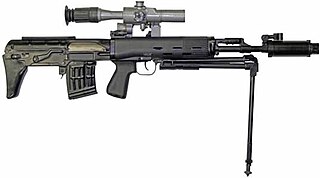
The OTs-03 SVU is a bullpup designated marksman rifle. The SVU was developed to meet the needs of the security forces of the Russian Ministry of Internal Affairs, such as OMON. The SVU was first seen in use in the First Chechen War. Originally, the plan was to just slightly modernize the aging SVD, but the designers eventually realised that the configuration of the weapon would have to be completely altered, leading to the creation of the SVU.

Zastava Arms is a Serbian manufacturer of firearms and artillery, based in Kragujevac, Serbia. In 1853, it was founded, and cast its first cannon. It is the leading producer of firearms in Serbia and is a large contributor to the local defense industry. Zastava Arms produces and exports a wide variety of products to over forty countries, including the Zastava M70, a Kalashnikov rifle.
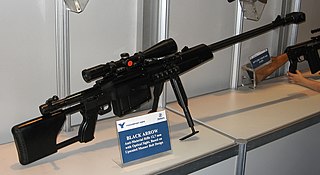
The M93 Black Arrow is a Serbian bolt-action 12.7×108mm anti-materiel rifle, developed and manufactured by Zastava Arms.
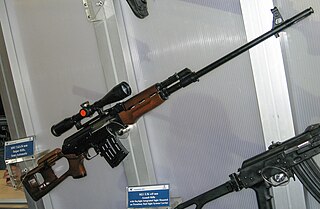
The Zastava M91 is a semi-automatic designated marksman rifle chambered in 7.62×54mmR, developed and manufactured by Zastava Arms company in Kragujevac, Serbia. Like its predecessor, the Zastava M76, the M91 is internally based upon an elongated version of the AK-47 design, but the M91 shares more external similarities with the Dragunov sniper rifle than the M76. The rifle is in service with the Serbian army, where it replaced the M76, which was chambered for the 7.92×57mm cartridge.

The PSO-1 is a 4×24 telescopic sight manufactured in Russia by the Novosibirsk instrument-making factory and issued with the Russian military Dragunov sniper rifle. It was introduced on 3 July 1963 together with the Dragunov sniper rifle.

The Territorial Defense of the Republic of Slovenia, also known as the Territorial Defense of Slovenia, was the predecessor of the Slovenian Armed Forces. It was named after the Yugoslav Territorial Defense.

Lewis Machine & Tool Company (LMT) is an American armaments company founded by Karl Lewis, in 1980. It manufactures weapon systems, including a variant of the M4 carbine and the M203 grenade launcher. Its products are used by the military forces of the United Kingdom, New Zealand, Estonia and the United States. It formerly produced forged FN FAL receivers for Illinois-based DS Arms.
The PSL is a Romanian designated marksman rifle. It is also called PSL-54C, Romak III, FPK and SSG-97. Though similar in appearance, mission and specifications to the SVD Dragunov, the PSL rifle is mechanically completely different as it is based on the RPK light machinegun, with its internals simply being scaled up to accommodate the more powerful 7.62×54mmR cartridge.

1PN58 is the GRAU index for a Soviet designed passive night scope for a range of Soviet designed small arms and grenade launchers. 1PN is the GRAU index of night vision devices, where PN stands for Nochnoy Pritsel meaning night sight. It is also called NSPUM. or NSPU-1. The 1PN58 was introduced into Soviet service in the early 1970s and is still used by many of the Soviet Union's successor states, and has been used in numerous conflicts around the world.

The Mauser Model 1895 is a bolt operated magazine fed rifle using the 7×57mm Mauser cartridge. It was exported to many overseas powers, including the Chilean forces which adopted as the Fusil Mauser Chileno Modelo 1895. It is the first major modification of the Mauser Model 1893 and was produced by Deutsche Waffen und Munitionsfabriken, known as DWM, and Ludwig Loewe Company from 1895 to 1900.

The SVCh is a semi-automatic designated marksman rifle/sniper rifle chambered for fully powered cartridges developed by the Kalashnikov Concern. It is designed to replace the SVD in the Army of the Russian Federation.






















